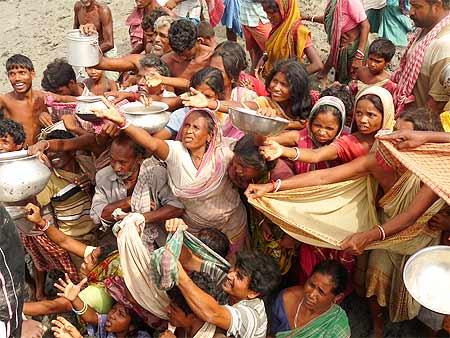
"Didi, have you come to make news out of our misery? Want to know our names? Please write down, my name is Hunger and this daughter of mine, who lost her father at 5, is called Thirst", says a woman in her mid 20s carrying a half-naked child in her arms.
As we enter Gosaba in Cyclone Aila-battered South 24 Parganas district, the wrath of nature is clear.
Out of 14 gram panchayats in Gosaba block, nine are badly hit and nearly 60,000 families are affected. Worst-hit areas include Amtakli Kumirmari, Chotomollahkhali, Lahiripur, Satjelia, Bally I & II, Kochuakhali, Gosaba, Rangabelia.
Having lived without proper food and drinking water for days, thousands of displaced people in the area are seething with discontent. And they are sick of politicians and journalists.
While they blame the former for capitalising on their plight to gain political mileage, they are tired of giving interviews to the media.
"You want to take our photographs, eh? Why don't you get us something to eat and drink instead?" thunders the woman, clad in a colourless sari torn in at least 10 places.
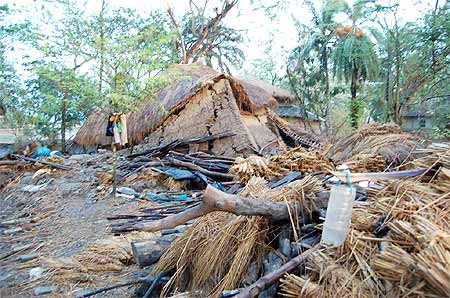
When we visit Gosaba on June 6, more than a fortnight after the devastating cyclone, no marked improvement can be noticed.
We hear over 40,000 people are fleeing the 10 islands, comprising 14 panchayats, apprehending fresh inundation during the full moon high tide.Though West Bengal Irrigation Minister Subhas Naskar put the figure of people having fled at 100,000, district magistrate Khalil Ahmed said they number 34,000.
According to official reports, people fleeing the area are being housed in 305 camps.
Though relief material is being transported to these camps on a regular basis, "they are just not enough to cater to the needs of the people," one of the camp officials told rediff.com on condition that he would not be identified for this report.
"More than dry food like puffed rice and chura, what people need the most is potable water. The entire area is flooded by saline water. Many people have fallen sick trying to drink that water," says the official. "It's a sad state of affairs."
"We are receiving water pouches from the state government but the supply is just not keeping up with the demand."In the Sunderbans, relief work is being carried out by state government officials, central government staff, non-government organisations and institutions like the Ramakrishna Mission and Bharat Sevashram Sangha.
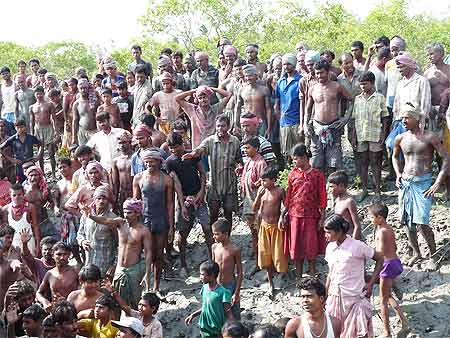
State Finance Minister Ashim Dasgupta recently told the media in Kolkata that the West Bengal government has asked army engineers and others to urgently repair damaged embankments before the full moon high tide.
However, with 800 breaches having occurred in several embankments -- 350 km in South 24 Parganas and 50 km in North 24 Parganas -- contractors employed to plug the gaps are unable to finish their jobs, displaced people told us.
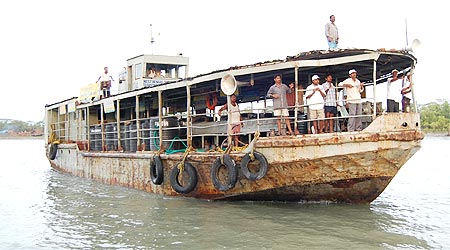
During our conversations with the victims at Gosaba, most are not willing to disclose their identities, lest they should be deprived of relief.
"Even in such distress, we are being used as pawns by our leaders. In Gosaba, each survivor is being given 2 to 4 kg of rice. Who gets how much is left to the block division officer's discretion," reveals a man in his mid 40s.
A resident of Bijoynagar, five members of his family were rendered homeless by Aila.
"What is even worse, politicians are squabbling to get the most amount of relief for areas under his or her jurisdiction," he adds.
About a week ago, Gosaba Block Development Officer Amiya Bhushan Chakrabarty was assaulted by a mob angered by insufficient relief work.
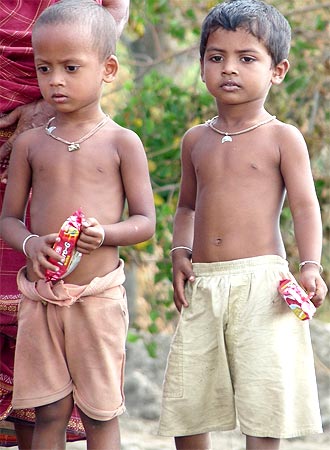
'There has been a lot of damage. But the tiger is a very strong animal,' he told the media a couple of days after the cylone hit the Sunderbans.
'The Royal Bengal Tigers of the Sunderbans can swim long distances. The only concern is that they may lose their bearings. If they don't know in which direction they have to move they may die because of exhaustion,' Bahuguna said, only confirming the death of five deer in the devastation.
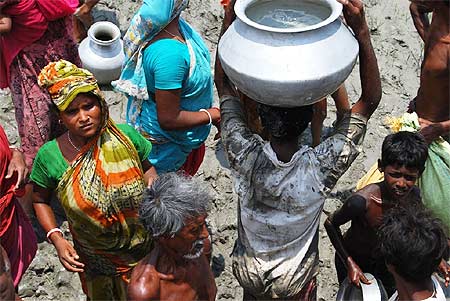
Forest department teams, which visited the area after the cyclone, did not encounter much damage, he adds.
West Bengal Forest Minister Ananta Roy has commissioned a survey -- to be completed by June 15 -- to determine how many animals were killed in the cyclone and after the disaster.
Home to 500 tigers until the late 1960s, the Sunderbans is believed to currently have 250 tigers. The Indian Statistical Institute estimates the tiger population as low as 75.
